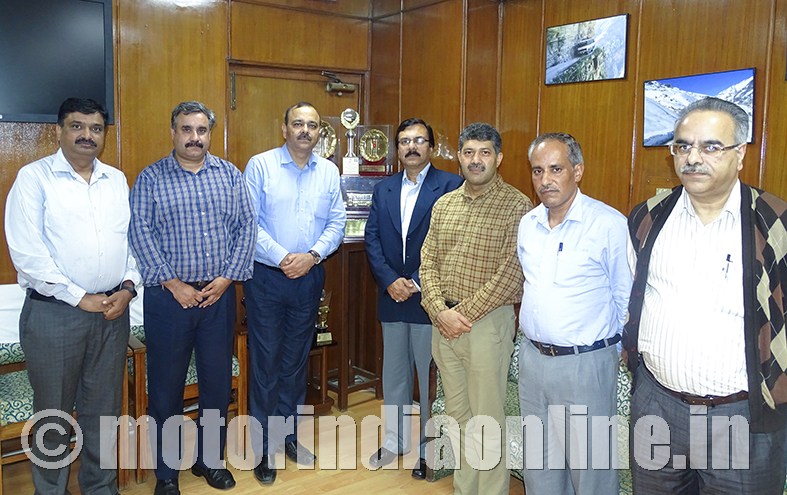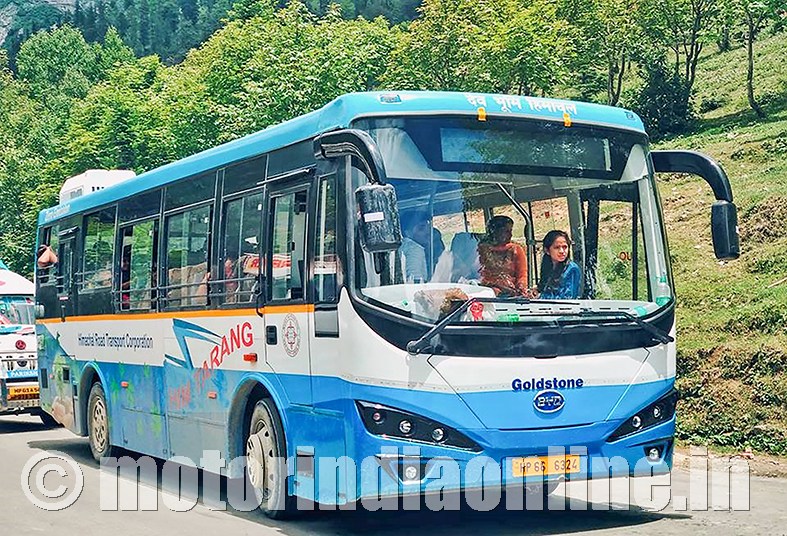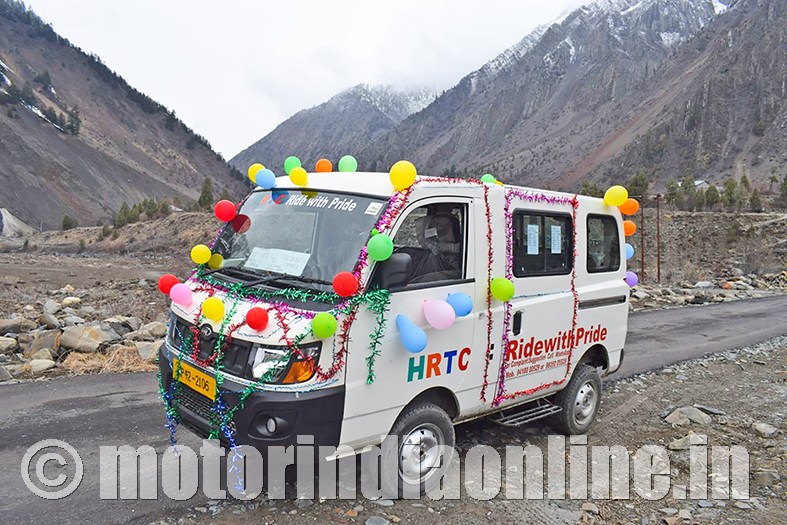A pioneer in operationalizing battery-electric buses and minivan e-taxis in the country, Himachal Road Transport Corporation (HRTC) is charged-up to offer cutting-edge transportation services to the people of Himachal, despite the upfront challenges posed by nature in the form of difficult terrain and dynamic weather conditions.

A simple YouTube search will direct you to some exhilarating clips of what bus transportation in the hill ranges of Himalayas actually means. More often than not, you would spot a HRTC bus in those clips, traversing through some of the highest motorable and most treacherous roads of the world, be it en route to Kaza, Leh, or Reckong Peo. In fact, the Delhi-Leh bus route operated by the corporation is the longest route by any state operator in India, extending for over 36 hours on an average.
Lately in the last two years, HRTC has earned popular limelight for plying battery-electric buses in the high-altitude Manali-Rohtang pass – the first zero-emission commercial bus operation at an altitude of 13,000 feet anywhere in the world! The STU has also inducted some battery-electric minivan as electric taxis in Shimla and other districts, together setting successful precedent and boosting confidence among other STUs to go for electric vehicles.
HRTC now boasts a healthy fleet size of 3,103 vehicles operating in 2,723 routes. Its fleet mix is very diverse – starting from 7-seater minivans and Chevrolet Tavera MUVs as taxis to 7-metre Force Travellers, 9-metre ‘midi’ fully-built buses from Tata Motors, SML Isuzu, Eicher, and Ashok Leyland for intra-city needs, 12-metre standard buses including air-conditioned Isuzu ones for inter-city routes, and premium fleet of Volvo luxury coaches. FY 2017-18 saw 380 new buses (including 25 Goldstone-BYD K7 e-buses) added to its fleet, along with 50 electric cabs (Mahindra e-Supro).
Blissful State Patronage
Asked on what was behind HRTC’s path-breaking spirit in adopting EVs, Dr. Sandeep Bhatnagar, IAS, Managing Director of the corporation points to the FAME scheme of the Union government that aimed to promote eco-friendly vehicles in the country. “It was the initiative of the government that showed us an opportunity, and we showed determined interest in getting the proposals approved”, he said, while adding that Himachal was the first state to get 25 e-buses under the FAME subsidy.
“Our corporation and the state government were devoted in finding better alternatives to offset environmental damages out of automobiles in the region. An NGT directive also sought to preserve the pristine environment of the Rohtang Pass region from automotive emissions. Since the scheme was readily available, we seized the opportunity”, he said. The MD also revealed that 50 more e-buses have been approved for the town of Shimla under Phase II of the FAME scheme.
The corporation says that the e-buses are under 3-year OEM warranty now and therefore offer hassle-free maintenance. “If we take up maintenance after the warranty period, the costs will be even lower as they are very less moving parts that demand frequent servicing. The running costs are also lower, just around Rs. 4 per km, as against Rs. 20 per km for a diesel bus in the same route”, notes Mr. Hemender Kr. Gupta, Chief General Manager, HRTC. He also added that Himachal is an electricity production surplus state, sourced entirely from renewable hydro-energy, and there is therefore absolutely no carbon footprint in operating e-buses whatsoever.
HRTC realizes its prime importance in the region. Its buses are the cheapest and the sole means of transportation in most of the regions for both passengers and low-volume luggages of horticulture or milk products from remote villages. “And hence there is enormous support from the state government in supporting our initiatives”, says Dr. Bhatnagar. “We contribute to the economic and social development of the state in a big way.”
Commuter-centric approach
The public transporter offers free rides and concessional tickets to even vulnerable sections of the local population, including 25 per cent concession in fares to women travelers, and free rides on Raksha Bhandhan and Karva chauth! “Concessions to women even acts as a great marketing strategy, as the entire family becomes a committed customer of HRTC”, says Mr. Gupta. It is also plying over 67 dedicated buses to commute school children in various towns and cities.
There hardly seems to be any safety threats for women commuters in buses and other public places unlike the scenario in some other states, which is worth appreciating. “Himachal people are very much socially responsible and law-abiding which greatly helps us in maintaining the cleanliness and good shape of government buses”, observes the Managing Director. This seems quite apparent in the way road users behave as well – the district of Shimla is a completely ‘over-taking free’ and ‘no-horn’ zone. I could hardly notice any driver breaching these diktats, be it bikers, private cars, or CVs.
In a bid to technologise its entire operations, the corporation in association with the concerned departments of the state government is working on a comprehensive IT system and connected infrastructure that will soon integrate all vehicles, bus stations, workshops, booking offices, and so on. Digital bus information systems are being set up at bus shelters, while mobile-based route selection and bus tracking are mulled over. “Our vision is to operate buses as a system – thereby providing superior value-added services to our commuters, while also improving our back-end efficiency and resource management to the fullest”, claims Mr. Gupta.
In fact, HRTC was one of the first STUs in the country to offer online booking of tickets for all types of buses under its operations. The corporation revealed that a revenue of around Rs. 70 lakhs per day is generated through online booking alone, which is very impressive. “As an active member of ASRTU, we get active support from our apex association and follow the best practices of every other STU in the country. Each one of us is excelling in our own comfort zones and many STUs have revolutionized the operations and successfully enabled new streams of revenue. We would like to have a steep learning curve in this regard”, comments Dr. Bhatnagar. “We even sit with local private bus operators in the region and seek better cooperation and assistance to each other. After all, all of us are providers of public transportation, a service of utmost importance to the society”, he adds.
Ms. Seema Takur – HRTC’s first woman driver
Annihilating all stereotypes and back-biting on a woman driving a commercial vehicle in the adventurous ghat routes of Himachal, Ms. Seema Takur is admired by many in the state, including her fellow drivers and HRTC officials. She drives a Chevrolet Tavera taxi of HRTC from Shimla to Solan twice every day, to and fro.
She is already qualified to drive 52-seater buses and is actively pursuing the corporation for a more challenging job of driving large buses. She is keen on driving Volvo buses as well. Seema strongly feels that access to opportunities is the major hurdle for women and other disadvantaged sections of the society. Once given an opportunity, skills and training can be imparted to anyone. Apart from her, 84 women conductors are also employed by HRTC.

